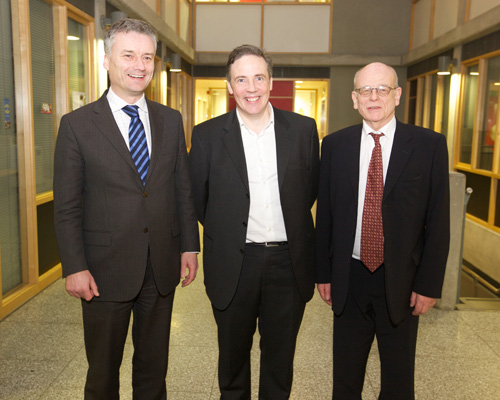Professor of Experimental Brain Research Shane O’Mara Gives Inaugural Lecture
Posted on: 04 March 2014
New developments in the understanding of how the brain makes memories were presented at an inaugural lecture given by Professor Shane O’Mara, Professor of Experimental Brain Research, in Trinity College Dublin.
In the lecture, entitled Exploring the ‘Enchanted Loom’: How the brain’s circuits and microcircuits might generate behaviour, Professor O’Mara of Trinity College Institute of Neuroscience and the School of Psychology, outlined his current research into the neurobiology and neuropsychology of learning and memory.
“The quest to discover how the brain makes memories speaks to the heart of what it is to be human. What would a life without our enduring personal record of our hopes, experiences, desires, wishes, needs, loves and hatreds be like? Without memory, we would live in a continual present tense; the experience of memory gives meaning and continuity to our lives. Additionally, understanding how these processes can go wrong as a result of simple ageing of the brain or as a result of disease is equally important.”

Dr Patrick Prendergast, Provost of Trinity College Dublin, Professor of Experimental Brain Research Shane O’Mara and Professor James Wickham, Dean of the Faculty of Arts, Humanities and Social Sciences
Event memories are known to be formed in the medial temporal lobe, prefrontal cortex and parietal cortex of the brain. But this is not the whole story, according to Professor O’Mara, who said that attention must now be paid to anatomically-deep and almost unexplored brain systems to fully understand how the brain makes memories. He outlined some new technologies researchers at Trinity have been employing to investigate these difficult to access areas of the brain.
“Our findings raise the possibility of a substantial subcortical memory system that may prove not to rely on the distributed networks across the medial temporal lobe, prefrontal cortex and parietal cortex. This has implications for how we diagnose and perhaps eventually treat disorders of memory that arise in amnesia, dementia and other conditions.”
Professor O’Mara also described other work being conducted on the claustrum, a largely-ignored brain region that has been theorised as being the orchestrator of conscious experience in the brain.
“Our work indicates that it has a very different role to that suggested to date. Instead, we suggest that the claustrum dynamically represents both extended space without the body and incorporates landmark information from the environment, and affects behavioural decision-making within this action space. New technologies that allow us to probe these brain areas are starting to allow us to map function and structure together – taking us some way to understanding the shifting patterns of the enchanted loom.“
Exploring the ‘Enchanted Loom’: How the brain’s circuits and microcircuits might generate behaviour was delivered by Professor O’Mara on Monday, March 3rd, 2014 in the Lloyd Building, Trinity College Dublin.
Media Contact:
Fiona Tyrrell, Press Officer for the Faculty of Arts, Humanities and Social Sciences, Trinity College Dublin | tyrrellf@tcd.ie | + 353 1 8964337
